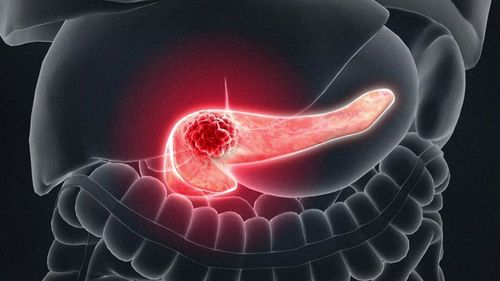This is an automatically translated article.
Topping the list of cancers with the highest mortality in Vietnam is pancreatic cancer. Therefore, it is not exaggerated to call pancreatic cancer a silent killer. So what is pancreatic cancer? Is pancreatic cancer curable? The following article will give you information about cancer known as the silent killer?
1. Pancreatic cancer - Cancer is known as the silent killer
What is pancreatic cancer? Is pancreatic cancer dangerous? Is pancreatic cancer dangerous? Pancreatic cancer is the third leading cause of cancer death in the United States. Pancreatic cancer is a type of cancer that begins in the pancreas. It begins when cells in the body begin to grow out of control. Pancreatic carcinoma is the most common type of pancreatic cancer.
The pancreas is an elongated organ located behind the lower part of the stomach, between the stomach and the spine. Exocrine cells, which make and release enzymes that aid in the digestion of food. Endocrine cells, which produce and release important hormones directly into the bloodstream, and control blood sugar levels. The head of the pancreas is located on the right side of the abdomen, behind where the stomach meets the duodenum (the first part of the small intestine). The body of the pancreas lies behind the stomach. The tail of the pancreas is located on the left side of the abdomen next to the spleen. The most common type of pancreatic cancer is pancreatic adenocarcinoma, which begins when exocrine cells in the pancreas begin to grow out of control. Most of the pancreas is made up of exocrine cells, which form exocrine glands and ducts. The exocrine glands make pancreatic enzymes that are released into the intestines to help the person digest food (especially fats). The enzymes are released into small tubes called ducts that eventually empty into the pancreatic duct. The pancreatic duct fuses with the common bile duct (the tube that carries bile from the liver), and empties into the duodenum (first part of the small intestine)
Endocrine cells make up a smaller percentage of the cells in the pancreas. These cells make important hormones like insulin and glucagon (which help control blood sugar) and release them directly into the bloodstream. Pancreatic neuroendocrine tumors begin in endocrine cells.
Pancreatic cancer risk factors: Anything that increases a person's chance of developing pancreatic cancer is a risk factor. Some risk factors can be changed, while others cannot.
Pancreatic cancer usually does not cause symptoms in its early stages. As cancer grows, it can begin to cause symptoms. These may include:
Pain in the stomach or back area Yellowing of your skin or the whites of your eyes (jaundice) Unexplained weight loss Pancreatic cancer symptoms Symptoms vary depending on your location cancer in the pancreas (in the head, body, or tail of the pancreas). Most pancreatic cancers start in the cells that produce digestive juices and are called exocrine tumors. The most common type of pancreatic cancer is called adenocarcinoma.
General symptoms: Pain in the stomach or back area; Jaundice; Weight loss; Diabetes ; Itchy; Intestinal disorders; Fever and shivering; Undigested; Blood clots ; Symptoms of endocrine pancreatic tumors.
2. Types and stages of pancreatic cancer
2.1. Types of Pancreatic Cancer There are many different types of cells in the pancreas. Knowing the cell type and location of cancer in the pancreas will help your doctor plan the best treatment for you, and whether pancreatic cancer is curable will no longer be a difficult question.
Cancer can start in the head, body or tail of the pancreas. The wide end of the pancreas is called the head. The thin end is called the tail. The bit in the middle is called the body.
Exocrine pancreatic cancer Adenocarcinomas Rarer types of exocrine pancreatic cancer include: Cysts; Acinar cell carcinoma; Endocrine pancreatic tumors; Pancreatoblastoma; Sarcomas of the pancreas; Lymphoma 2.2. Pancreatic cancer stages. Pancreatic cancer stages: After someone is diagnosed with pancreatic cancer, doctors try to find out if it has spread, and if so, how far. This process is called a phase. Cancer stage describes the extent of cancer in the body. It helps determine the severity of the cancer and the best treatment. Doctors also use a cancer's stage when talking about survival statistics.
Pancreatic cancer is the earliest stage 0 (carcinoma in situ), then ranges from stage I (1) to stage IV (4). As a rule, the lower the number, the less likely the cancer will metastasize. A higher number, such as stage IV, means a more advanced cancer. Cancers with similar stages tend to look similar and are often treated the same way.
Cancer staging is determined based on 3 main pieces of information: The extent of the tumor (T): How large is the tumor and has it grown outside the pancreas into nearby blood vessels? Spread to nearby lymph nodes (N): Has the cancer spread to nearby lymph nodes? If so, how many lymph nodes are cancerous? Spread (metastasis) to distant sites (M): The cancer has spread to distant lymph nodes or distant organs such as the liver, peritoneum (the lining of the abdominal cavity), lungs, or bones. ?
3. Is pancreatic cancer curable, is pancreatic cancer dangerous?
Survival rates for pancreatic cancer: Survival rates can give you an idea of what percentage of people with the same type and stage of cancer are still alive for a given time period ( usually 5 years) after they are diagnosed. They can't tell you how long you'll live, but they can help you better understand the likelihood of treatment success. What is the 5-year survival rate? Relative survival rates compare people with the same type and stage of pancreatic cancer with those in the overall population. For example, if the 5-year relative survival rate for a particular stage of pancreatic cancer is 50%, that means that people with that cancer are, on average, about 50% more likely to get that cancer. people who don't have that cancer. live for at least 5 years after diagnosis.
Where do these numbers come from? The American Cancer Society relies on information from the SEER* database, maintained by the National Cancer Institute (NCI), to provide statistics on survival for different types of cancer. .
The SEER database tracks 5-year relative survival rates for pancreatic cancer in the United States, based on how far the cancer has spread. However, the SEER database does not group cancers by AJCC TNM stages (stage 1, stage 2, stage 3, etc.). Instead, it groups cancers into focal, regional, and distant stages:
Localized: There is no indication that the cancer has spread beyond the pancreas. Regional: Cancer has spread from the pancreas to nearby structures or lymph nodes. Distant: Cancer has spread to distant parts of the body such as the lungs, liver, or bones. Relative 5-year survival rates for pancreatic cancer
4. Risk factors for pancreatic cancer
Modifiable factors include: Smoking and tobacco use: Obesity : Other pancreatic cancer risk factors that cannot be changed, including: Age, race, family history , diabetes, chronic pancreatitis. Not everyone with the above risk factors gets pancreatic cancer, and whether pancreatic cancer is dangerous if you have risk factors you should discuss with your doctor.
Please dial HOTLINE for more information or register for an appointment HERE. Download MyVinmec app to make appointments faster and to manage your bookings easily.
References: cancer.org, cancerresearchuk.org, mdanderson.org













